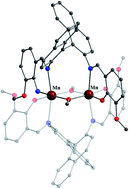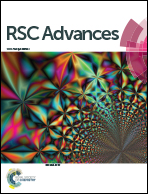A new chiral dimanganese(iii) complex: synthesis, crystal structure, spectroscopic, magnetic, and catalytic properties†
Abstract
Two enantiomeric complexes of formula [MnIII2(μ-OCH3)2(R-valBINAM)2]·1.75DMF (1) and [MnIII2(μ-OCH3)2(S-valBINAM)2]·2DMF (2) [valBINAM = 1,1′-binaphthalene-2,2′-bis(3-methoxysalicylideneiminate)] have been synthesized using as a ligand the chiral Schiff bases resulting from the condensation reactions between o-vanillin and the chiral 1,1′-binaphthyl-2,2′-diamine. The structures of 1 and 2 which have been solved by single crystal X-ray diffraction consist of neutral dimers, the manganese(III) ions being bridged by two methoxido anions, arising from the solvent, and by two valBINAM2− ligands. Their circular dichroism spectra at room temperature emphasize the occurrence of the exciton coupling effect. The cryomagnetic measurements in the temperature range 2.0–300, for compound 2, reveal the occurrence of antiferromagnetic interactions between the two MnIII ions (J = −35.5 cm−1, the Hamiltonian being defined as H = −JS1S2). The catalytic behaviour of these complexes was checked in the epoxidation of methyl trans-cinnamate with N-methylmorpholine-N-oxide as an oxidant. The influence of the solvent was also investigated. The reactions in a CH3CN/H2O (5 : 1 v/v) solvent mixture afforded total chemo- and enantioselectivity in the desired epoxides.


 Please wait while we load your content...
Please wait while we load your content...